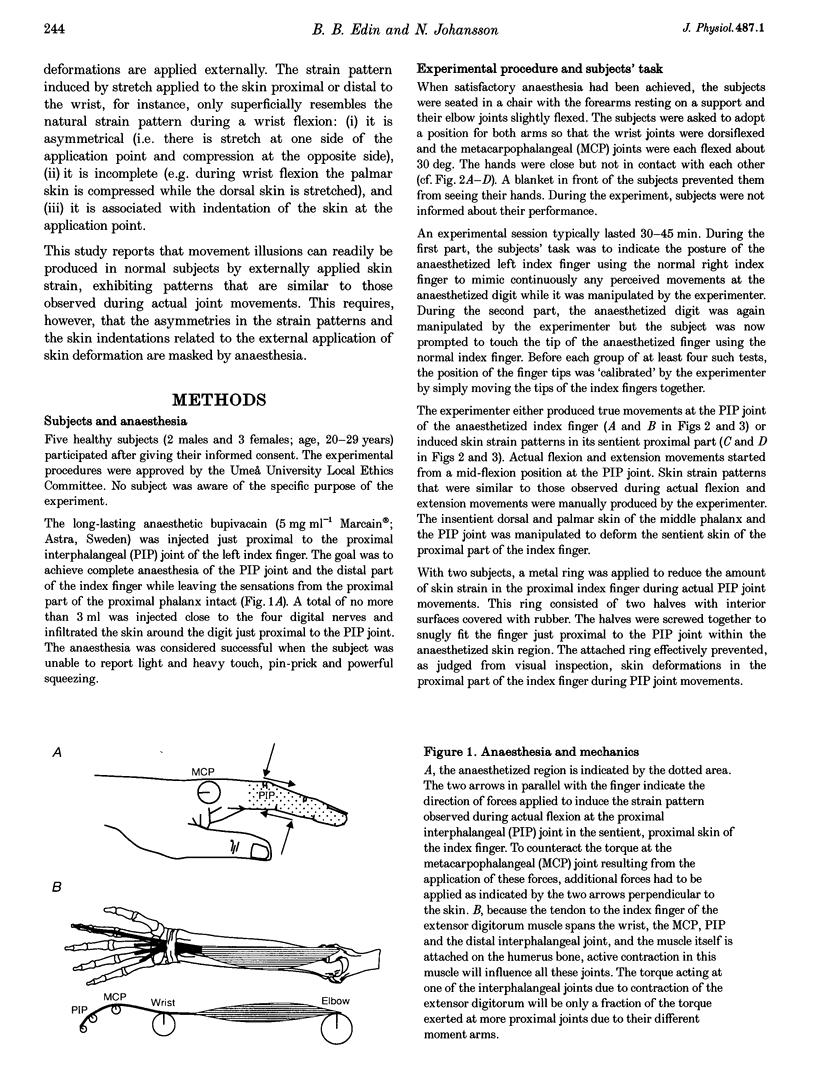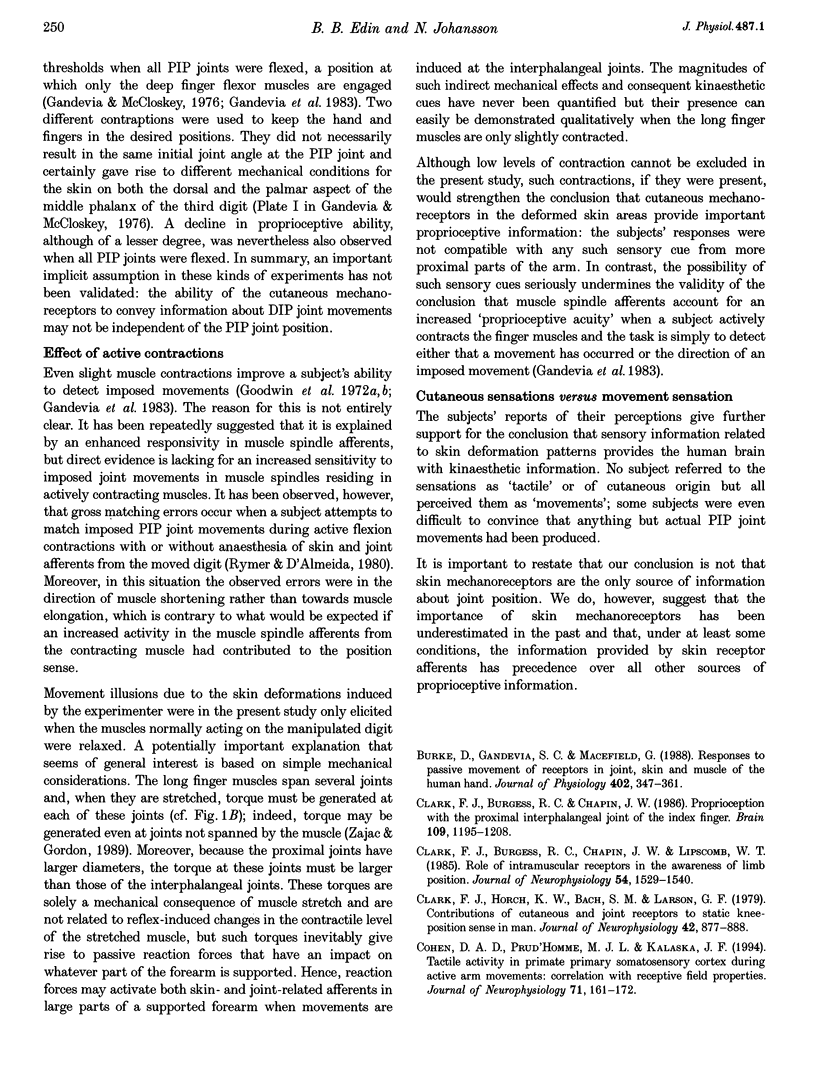Abstract
1. We investigated the contribution of skin strain-related sensory inputs to movement perception and execution in five normal volunteers. The dorsal and palmar skin of the middle phalanx and the proximal interphalangeal (PIP) joint were manipulated to generate specific strain patterns in the proximal part of the index finger. To mask sensations directly related to this manipulation, skin and deeper tissues were blocked distal to the mid-portion of the proximal phalanx of the index finger by local anaesthesia. 2. Subjects were asked to move their normal right index finger either to mimic any perceived movements of the anaesthetized finger or to touch the tip of the insentient finger. 3. All subjects readily reproduced actual movements induced by the experimenter at the anaesthetized PIP joint. However, all subjects also generated flexion movements when the experimenter did not induce actual movement but produced deformations in the sentient proximal skin that were similar to those observed during actual PIP joint flexion. Likewise, the subjects indicated extension movement at the PIP joint when strain patterns corresponding to extension movements were induced. 4. In contrast, when the skin strain in the proximal part of the index finger was damped by a ring applied just proximal to the PIP joint within the anaesthetized skin area, both tested subjects failed to perceive PIP movements that actually took place.(ABSTRACT TRUNCATED AT 250 WORDS)
Full text
PDF








Images in this article
Selected References
These references are in PubMed. This may not be the complete list of references from this article.
- Burke D., Gandevia S. C., Macefield G. Responses to passive movement of receptors in joint, skin and muscle of the human hand. J Physiol. 1988 Aug;402:347–361. doi: 10.1113/jphysiol.1988.sp017208. [DOI] [PMC free article] [PubMed] [Google Scholar]
- Clark F. J., Burgess R. C., Chapin J. W., Lipscomb W. T. Role of intramuscular receptors in the awareness of limb position. J Neurophysiol. 1985 Dec;54(6):1529–1540. doi: 10.1152/jn.1985.54.6.1529. [DOI] [PubMed] [Google Scholar]
- Clark F. J., Burgess R. C., Chapin J. W. Proprioception with the proximal interphalangeal joint of the index finger. Evidence for a movement sense without a static-position sense. Brain. 1986 Dec;109(Pt 6):1195–1208. doi: 10.1093/brain/109.6.1195. [DOI] [PubMed] [Google Scholar]
- Clark F. J., Horch K. W., Bach S. M., Larson G. F. Contributions of cutaneous and joint receptors to static knee-position sense in man. J Neurophysiol. 1979 May;42(3):877–888. doi: 10.1152/jn.1979.42.3.877. [DOI] [PubMed] [Google Scholar]
- Cohen D. A., Prud'homme M. J., Kalaska J. F. Tactile activity in primate primary somatosensory cortex during active arm movements: correlation with receptive field properties. J Neurophysiol. 1994 Jan;71(1):161–172. doi: 10.1152/jn.1994.71.1.161. [DOI] [PubMed] [Google Scholar]
- De Domenico G., McCloskey D. I. Accuracy of voluntary movements at the thumb and elbow joints. Exp Brain Res. 1987;65(2):471–478. doi: 10.1007/BF00236321. [DOI] [PubMed] [Google Scholar]
- Edin B. B., Abbs J. H. Finger movement responses of cutaneous mechanoreceptors in the dorsal skin of the human hand. J Neurophysiol. 1991 Mar;65(3):657–670. doi: 10.1152/jn.1991.65.3.657. [DOI] [PubMed] [Google Scholar]
- Edin B. B. Finger joint movement sensitivity of non-cutaneous mechanoreceptor afferents in the human radial nerve. Exp Brain Res. 1990;82(2):417–422. doi: 10.1007/BF00231261. [DOI] [PubMed] [Google Scholar]
- Edin B. B. Quantitative analysis of static strain sensitivity in human mechanoreceptors from hairy skin. J Neurophysiol. 1992 May;67(5):1105–1113. doi: 10.1152/jn.1992.67.5.1105. [DOI] [PubMed] [Google Scholar]
- Ferrell W. R., Gandevia S. C., McCloskey D. I. The role of joint receptors in human kinaesthesia when intramuscular receptors cannot contribute. J Physiol. 1987 May;386:63–71. doi: 10.1113/jphysiol.1987.sp016522. [DOI] [PMC free article] [PubMed] [Google Scholar]
- Ferrell W. R., Smith A. The effect of digital nerve block on position sense at the proximal interphalangeal joint of the human index finger. Brain Res. 1987 Nov 10;425(2):369–371. doi: 10.1016/0006-8993(87)90522-1. [DOI] [PubMed] [Google Scholar]
- Gandevia S. C., Hall L. A., McCloskey D. I., Potter E. K. Proprioceptive sensation at the terminal joint of the middle finger. J Physiol. 1983 Feb;335:507–517. doi: 10.1113/jphysiol.1983.sp014547. [DOI] [PMC free article] [PubMed] [Google Scholar]
- Gandevia S. C., McCloskey D. I. Joint sense, muscle sense, and their combination as position sense, measured at the distal interphalangeal joint of the middle finger. J Physiol. 1976 Sep;260(2):387–407. doi: 10.1113/jphysiol.1976.sp011521. [DOI] [PMC free article] [PubMed] [Google Scholar]
- Goodwin G. M., McCloskey D. I., Matthews P. B. Proprioceptive illusions induced by muscle vibration: contribution by muscle spindles to perception? Science. 1972 Mar 24;175(4028):1382–1384. doi: 10.1126/science.175.4028.1382. [DOI] [PubMed] [Google Scholar]
- Goodwin G. M., McCloskey D. I., Matthews P. B. The contribution of muscle afferents to kinaesthesia shown by vibration induced illusions of movement and by the effects of paralysing joint afferents. Brain. 1972;95(4):705–748. doi: 10.1093/brain/95.4.705. [DOI] [PubMed] [Google Scholar]
- Goodwin G. M., McCloskey D. I., Matthews P. B. The persistence of appreciable kinesthesia after paralysing joint afferents but preserving muscle afferents. Brain Res. 1972 Feb 25;37(2):326–329. doi: 10.1016/0006-8993(72)90679-8. [DOI] [PubMed] [Google Scholar]
- Grigg P., Greenspan B. J. Response of primate joint afferent neurons to mechanical stimulation of knee joint. J Neurophysiol. 1977 Jan;40(1):1–8. doi: 10.1152/jn.1977.40.1.1. [DOI] [PubMed] [Google Scholar]
- Hall L. A., McCloskey D. I. Detections of movements imposed on finger, elbow and shoulder joints. J Physiol. 1983 Feb;335:519–533. doi: 10.1113/jphysiol.1983.sp014548. [DOI] [PMC free article] [PubMed] [Google Scholar]
- Hulliger M., Nordh E., Thelin A. E., Vallbo A. B. The responses of afferent fibres from the glabrous skin of the hand during voluntary finger movements in man. J Physiol. 1979 Jun;291:233–249. doi: 10.1113/jphysiol.1979.sp012809. [DOI] [PMC free article] [PubMed] [Google Scholar]
- Matthews P. B. Proprioceptors and their contribution to somatosensory mapping: complex messages require complex processing. Can J Physiol Pharmacol. 1988 Apr;66(4):430–438. doi: 10.1139/y88-073. [DOI] [PubMed] [Google Scholar]
- McCloskey D. I. Kinesthetic sensibility. Physiol Rev. 1978 Oct;58(4):763–820. doi: 10.1152/physrev.1978.58.4.763. [DOI] [PubMed] [Google Scholar]
- Millar J. Joint afferent fibres responding to muscle stretch, vibration and contraction. Brain Res. 1973 Dec 7;63:380–383. doi: 10.1016/0006-8993(73)90108-x. [DOI] [PubMed] [Google Scholar]
- Rymer W. Z., D'Almeida A. Joint position sense: the effects of muscle contraction. Brain. 1980 Mar;103(1):1–22. doi: 10.1093/brain/103.1.1. [DOI] [PubMed] [Google Scholar]
- Sittig A. C., Denier van der Gon J. J., Gielen C. C., van Wijk A. J. The attainment of target position during step-tracking movements despite a shift of initial position. Exp Brain Res. 1985;60(2):407–410. doi: 10.1007/BF00235937. [DOI] [PubMed] [Google Scholar]
- Zajac F. E., Gordon M. E. Determining muscle's force and action in multi-articular movement. Exerc Sport Sci Rev. 1989;17:187–230. [PubMed] [Google Scholar]




